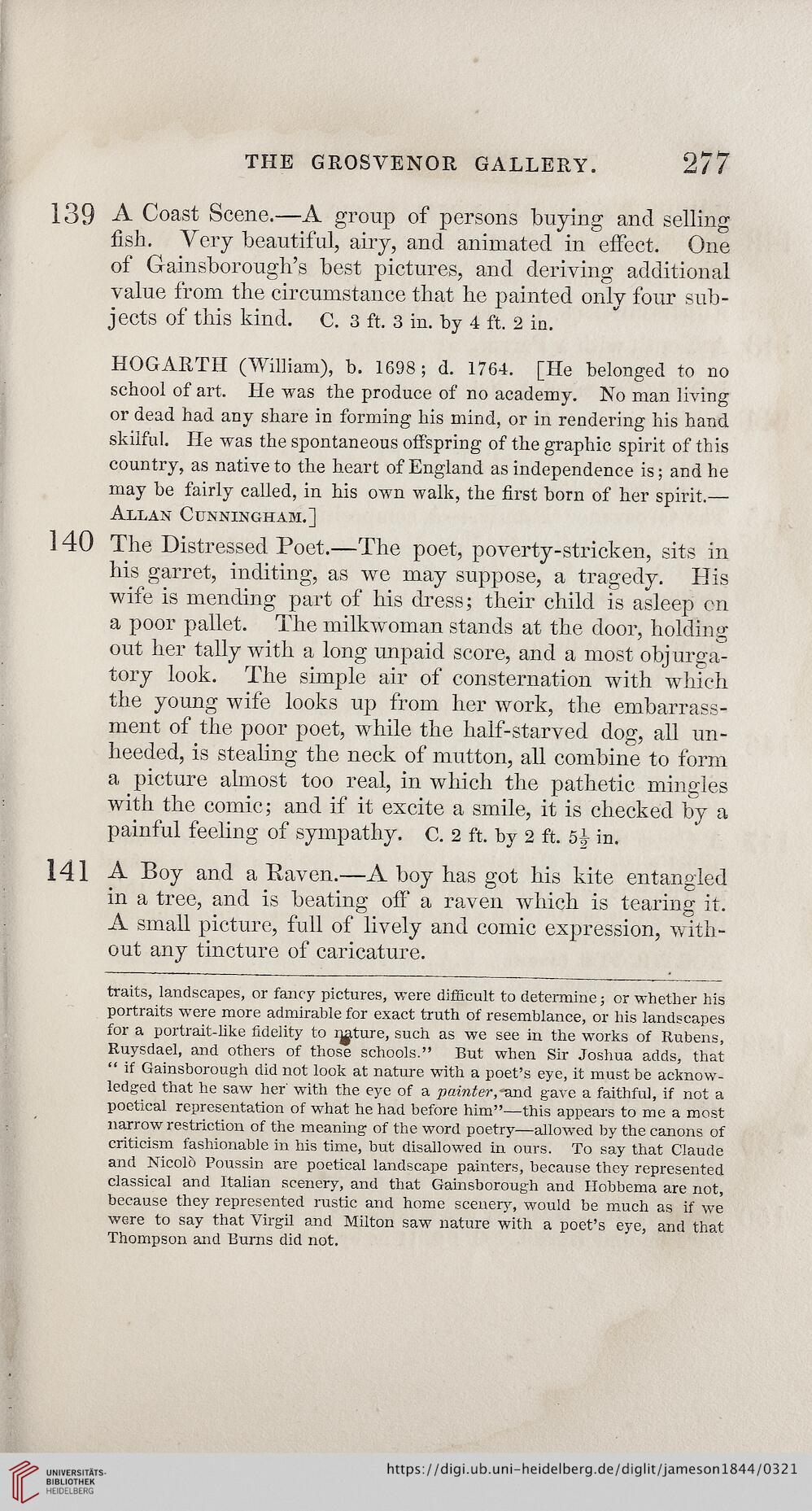THE GROSVENOR GALLERY. 277
139 A Coast Scene.—A group of persons buying and selling
fish. Very beautiful, airy, and animated in effect. One
of Gainsborough’s best pictures, and deriving additional
value from the circumstance that he painted only four sub-
jects of this kind. C. 3 ft. 3 in. by 4 ft. 2 in.
HOGARTH (William), b. 1698; d. 1764. [He belonged to no
school of art. He was the produce of no academy. No man living
or dead had any share in forming his mind, or in rendering his hand
skilful. He was the spontaneous offspring of the graphic spirit of this
country, as native to the heart of England as independence is; and he
may be fairly called, in his own walk, the first born of her spirit.—
Allan Cunningham.]
140 The Distressed Poet.—The poet, poverty-stricken, sits in
his garret, inditing, as we may suppose, a tragedy. His
wife is mending part of his dress; their child is asleep on
a poor pallet. The milkwoman stands at the door, holding
out her tally with a long unpaid score, and a most objurga-
tory look. The simple air of consternation with which
the young wife looks up from her work, the embarrass-
ment of the poor poet, while the half-starved dog, all un-
heeded, is stealing the neck of mutton, all combine to form
a picture almost too real, in which the pathetic mingles
with the comic; and if it excite a smile, it is checked by a
painful feeling of sympathy. C. 2 ft. by 2 ft. 5| in.
141 A Boy and a Raven.—A boy has got his kite entangled
in a tree, and is beating off a raven which is tearing it.
A small picture, full of lively and comic expression, with-
out any tincture of caricature.
traits, landscapes, or fancy pictures, were difficult to determine; or whether his
portraits were more admirable for exact truth of resemblance, or his landscapes
for a portrait-like fidelity to ij^ture, such as we see in the works of Rubens,
Ruysdael, and others of those schools.” But when Sir Joshua adds, that
“ if Gainsborough did not look at nature with a poet’s eye, it must be acknow-
ledged that he saw her' with the eye of a painter,-and. gave a faithful, if not a
poetical representation of what he had before him”—this appeal's to me a most
narrow restriction of the meaning of the word poetry—allowed by the canons of
criticism fashionable in his time, but disallowed in ours. To say that Claude
and Nicolo Poussin are poetical landscape painters, because they represented
classical and Italian scenery, and that Gainsborough and Hobbema are not,
because they represented rustic and home scenery, would be much as if we
were to say that Virgil and Milton saw nature with a poet’s eye, and that
Thompson and Burns did not.
139 A Coast Scene.—A group of persons buying and selling
fish. Very beautiful, airy, and animated in effect. One
of Gainsborough’s best pictures, and deriving additional
value from the circumstance that he painted only four sub-
jects of this kind. C. 3 ft. 3 in. by 4 ft. 2 in.
HOGARTH (William), b. 1698; d. 1764. [He belonged to no
school of art. He was the produce of no academy. No man living
or dead had any share in forming his mind, or in rendering his hand
skilful. He was the spontaneous offspring of the graphic spirit of this
country, as native to the heart of England as independence is; and he
may be fairly called, in his own walk, the first born of her spirit.—
Allan Cunningham.]
140 The Distressed Poet.—The poet, poverty-stricken, sits in
his garret, inditing, as we may suppose, a tragedy. His
wife is mending part of his dress; their child is asleep on
a poor pallet. The milkwoman stands at the door, holding
out her tally with a long unpaid score, and a most objurga-
tory look. The simple air of consternation with which
the young wife looks up from her work, the embarrass-
ment of the poor poet, while the half-starved dog, all un-
heeded, is stealing the neck of mutton, all combine to form
a picture almost too real, in which the pathetic mingles
with the comic; and if it excite a smile, it is checked by a
painful feeling of sympathy. C. 2 ft. by 2 ft. 5| in.
141 A Boy and a Raven.—A boy has got his kite entangled
in a tree, and is beating off a raven which is tearing it.
A small picture, full of lively and comic expression, with-
out any tincture of caricature.
traits, landscapes, or fancy pictures, were difficult to determine; or whether his
portraits were more admirable for exact truth of resemblance, or his landscapes
for a portrait-like fidelity to ij^ture, such as we see in the works of Rubens,
Ruysdael, and others of those schools.” But when Sir Joshua adds, that
“ if Gainsborough did not look at nature with a poet’s eye, it must be acknow-
ledged that he saw her' with the eye of a painter,-and. gave a faithful, if not a
poetical representation of what he had before him”—this appeal's to me a most
narrow restriction of the meaning of the word poetry—allowed by the canons of
criticism fashionable in his time, but disallowed in ours. To say that Claude
and Nicolo Poussin are poetical landscape painters, because they represented
classical and Italian scenery, and that Gainsborough and Hobbema are not,
because they represented rustic and home scenery, would be much as if we
were to say that Virgil and Milton saw nature with a poet’s eye, and that
Thompson and Burns did not.




